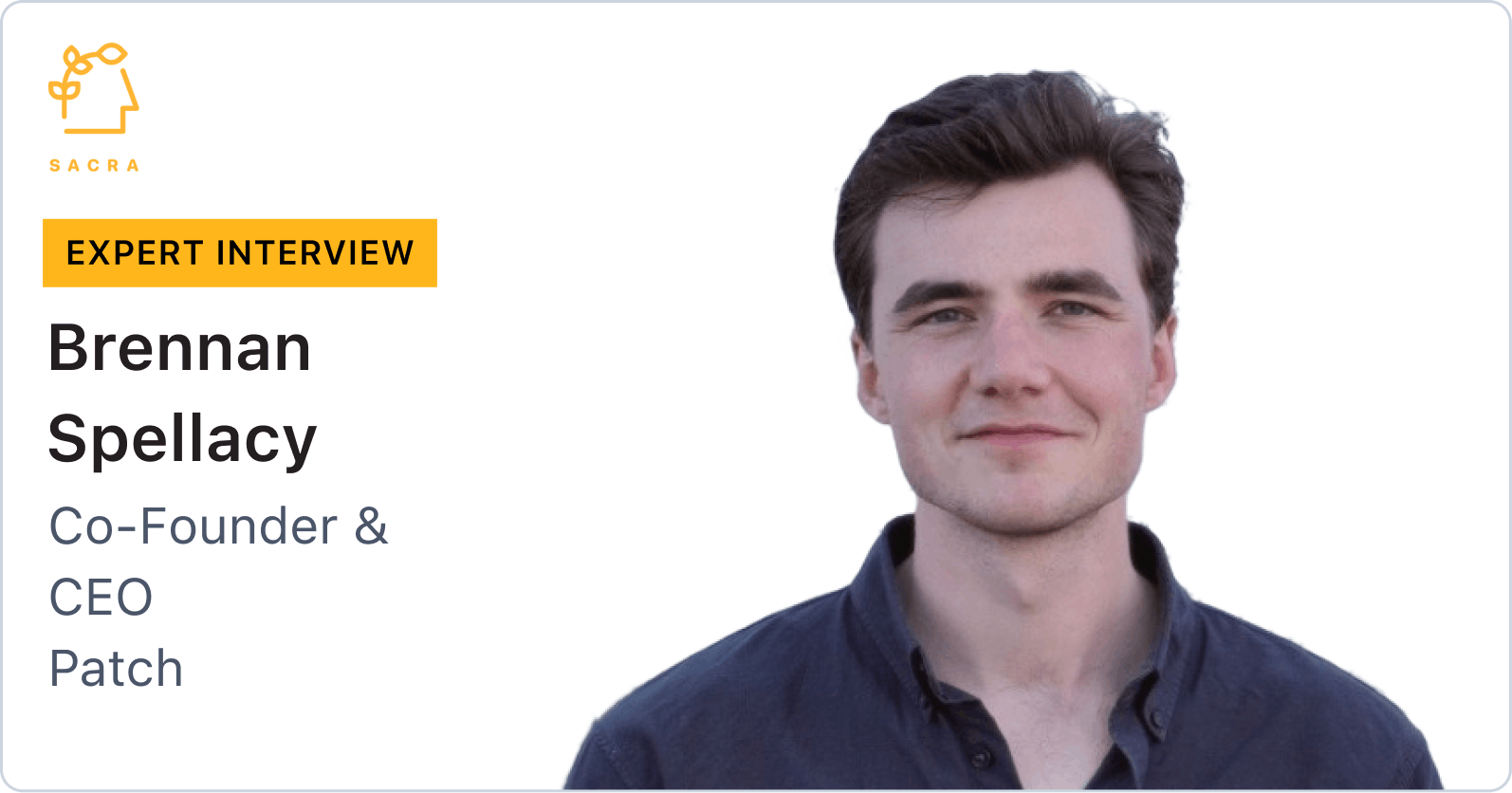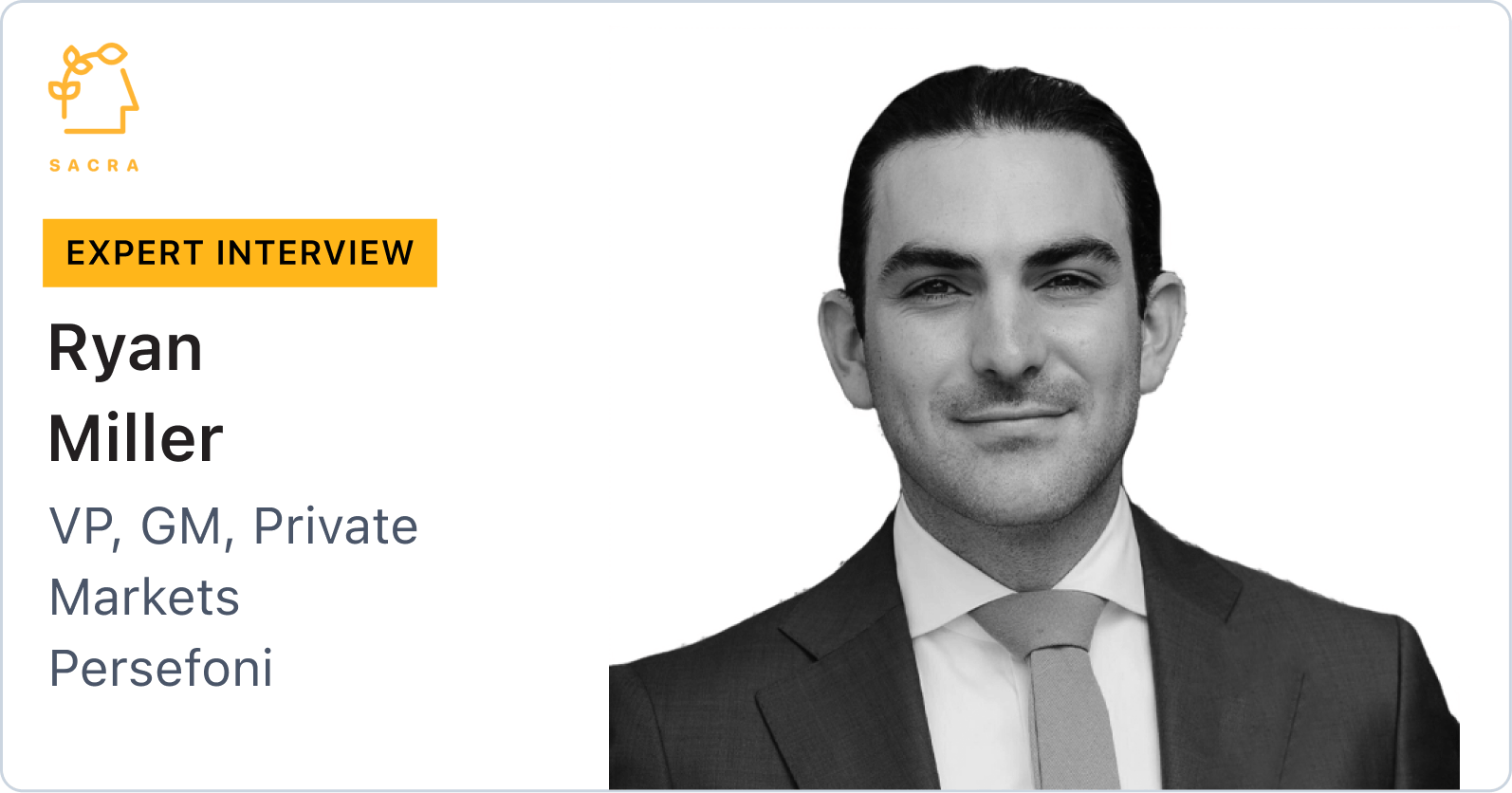Brennan Spellacy, CEO of Patch, on the API layer of the carbon stack
 Jan-Erik Asplund
Jan-Erik Asplund

Background
Brennan Spellacy is the co-founder and CEO of Patch, an API connecting carbon offsetting projects with companies and funds that want to offset emissions. We talked to Brennan to learn more about how Patch serves as a technical layer in the emerging carbon economy and how their two-sided marketplace of projects and companies functions.
Questions
- What is Patch, what is the problem you're solving, and what are some of the core use cases for the product?
- What is the process without Patch in the picture or pre-Patch that companies would've had to go through to do this?
- Why was the API-first aspect of Patch important to you? Why do you think that's necessary to make this business work?
- How do you build trust on the marketplace?
- How you think about attracting projects to the supply side? What is the value proposition for them?
- Are there ways that Patch can actively work to improve the quality and quantity of the projects on the supply side of this carbon offset marketplace?
- How has the quality of projects on the supply side of the carbon offset marketplace changed? Are there big new technologies emerging? What’s growing?
- What are some of the big considerations when a company is deciding what kind of carbon offsetting project to go with?
- You have partnerships with a few other big players in this market like Persefoni. How do you think about the importance of partnerships in this market?
- As an API-based carbon offset company, do you see Stripe and Stripe Climate as competitive. How do you think about your positioning with regard to Stripe?
- How do you think about the positioning of Patch with respect to companies like Cloverly, Cooler, Dev, and Pachama?
- A lot of the clean tech companies of a decade ago really struggled. Are there lessons that companies like Patch in this new wave of “clean tech” startups are taking away from the past there?
- What does the developer deployment of Patch look like? What does Patch plug into? What are the data sources and outputs?
- What does the typical “carbon stack” look like for, let’s say, an ecommerce company or marketplace?
- How do you think about the regulatory landscape here? How big of a tailwind are the various pieces of legislation floating around in the U.S. and elsewhere mandating carbon disclosures?
- Where do you see the sea change in this space coming from? When do we reach a point that consumers actively demand carbon disclosures from brands—is that organic consumer sentiment that will drive change, or regulations?
- Given some of the ethical guardrails in the space, where does it make sense for Patch to expand? If everything goes right, what does Patch become in 5 years?
Interview
What is Patch, what is the problem you're solving, and what are some of the core use cases for the product?
Patch is an API-first marketplace for climate action.
What that means is we partner with a wide variety of what are called carbon removal or carbon credit developers. These are folks who develop land in such a way that it sequesters carbon dioxide quickly. That could be through something as familiar as reforestation to as foreign direct air capture. Patch supports 9 to 10 major chemical pathways to sequence carbon dioxide across 30 to 40 different project developers representing 60 to 70 different projects.
On the buy side, we digitize this capacity so that buyers can build carbon credit portfolios more easily.
There are two reasons you might want to build a carbon credit portfolio.
One is that you have a net zero commitment you're trying to make. You’re a corporation, you've said you're going to be at net-zero by 2030, 2040 or 2050 and you’d like to use removals to compensate for hard-to-abate emissions within your company.
The other use case is embedding some form of climate action into a product or service. For example, when you pay for something using the Afterpay app, you have the ability to compensate for the carbon footprint of your purchase by transacting with different types of carbon removal projects. That infrastructure is powered by Patch’s API.
What is the process without Patch in the picture or pre-Patch that companies would've had to go through to do this?
There's primarily two ways you would go about this before Patch.
The first is you would go through some sort of traditional carbon credit broker that would have relationships with different projects. But besides it being more effort to survey a bunch of different brokers who are typically in a bunch of different places, with a broker, you're actually left holding the bag if anything ever happens to those carbon credits. There's essentially no legal liability securing the transaction.
With Patch, we have a robust supplier agreement that allows us to protect buyers. If something were to go awry with the underlying asset, we have the appropriate financial and legal recourse in place in order to make that right.
There is a huge trust element here—trust that the digital derivative you are transacting in is actually secured by some high integrity physical asset—and that's an element Patch layers on top.
The other way you might go about it is going directly to the projects. The pain there is that if you're building a diverse portfolio across maybe 10 to 15 different projects, it typically means you have to negotiate 10 to 15 different contracts as well as establish 10 to 15 different relationships. There's a huge hurdle to overcome there because again, going back to the trust element, what happens if something goes right or goes wrong? You may not know what you don't know in some cases. You might be signing yourself up for something but you don't really intend to do so.
All this this legal and financial crust is abstracted away when you're on Patch.
Why was the API-first aspect of Patch important to you? Why do you think that's necessary to make this business work?
Patch is not exclusively an API—we have loads of folks who just use the dashboard product. However, the big underlying thesis for Patch is that in order to get a billion people to do something it needs to be both in workflows that already exist, and the only way to do that is with APIs versus having separate software systems you go to to take climate action.
In many cases, as a corporate buyer, you may actually want a “one stop shop”, where you can do your accounting reduction strategies and carbon compensation all in one singular software system.
The API is also important is because of the other software systems out there today, like the Persefonis or the Normatives of the world. These are carbon accounting tools which help you understand your footprint and provide production strategies that also need this functionality.
For carbon accounting players, the ability to do carbon compensation or carbon removal is a must-have, non-differentiating feature in a lot of cases. Their users expect that, but that's not going to be why they win over one carbon accounting tool to another.
It's a table stakes element that isn't truly a special sauce for the carbon accounting players, so it’s a prime candidate to be outsourced. Our API is critical in order to enable those types of use cases as well as other use cases related to any form of automation of climate action.
How do you build trust on the marketplace?
When you get out of an Uber, there's an obvious “delivery”—you got to where you were trying to go. With carbon markets, you have a digital asset that maps to a physical asset that moves an invisible gas over time, so there's a lot less obvious proof that something is taking place.
To get listed on Patch, the data we require if you are a reforestation provider versus a direct air carbon capture provider are fundamentally different.
First and foremost, the high-level shape of the data typically comes in the form of registry data. There are these external systems that are called carbon credit registries where the credit is actually minted. In order to get a credit, you have to go through a process called verification. You can almost imagine a world where you have a Deloitte-type character auditing the work of the project, and them saying, "Okay, you've minted that you've removed 10, 20, 30, 100 tons of carbon so you get 10, 20, 30, 100 carbon credits."
We take that data and pull that into our system. That’s the minimum bar in order to get listed, though that's not usually enough.
Post-transaction, we work with third-party monitoring systems to understand if the asset that carbon credit is secured against is still alive and operational. There have been instances where forests in the Pacific Northwest used for carbon credit projects have burned down and the holders of those carbon credits were left holding the bag, so we're securing against that post-transaction trust element as well.
How you think about attracting projects to the supply side? What is the value proposition for them?
The first piece is incremental revenue. The second piece is increased operational leverage. We build a significant amount of software for these carbon project developers in order to help them scale their business: primarily around commercialization, inventory management, and things like that.
When you have both—we’re basically going to help you make more money, plus make money you're already earning higher margin—it's a pretty compelling value proposition.
Are there ways that Patch can actively work to improve the quality and quantity of the projects on the supply side of this carbon offset marketplace?
Patch, because of the role we play in carbon markets today, can never be a verifier ourselves. We believe it's structurally unethical to be both an exchange and a credit rating agency at the same time.
What that means is that we're always going to partner with third parties to produce that verification data, but we will present it in a way that it's easy to digest.
We talked about increasing the quality of the broader ecosystem. The role Patch plays is really making sure that buyers truly understand what they are buying.
We standardize and aggregate the supply side of the marketplace, but we also make it easy to make an apples-to-apples comparison of the strengths and weaknesses of different technology and project types. That is the role we see ourselves playing. By driving that transparency and ensuring that information is transparent, we believe the best will bubble to the top.
How has the quality of projects on the supply side of the carbon offset marketplace changed? Are there big new technologies emerging? What’s growing?
We're really in a Renaissance of project quality. A lot of the really promising projects on the Patch platform are still in the early stages of development, whether it's sequestering carbon in cement or kelp and sinking that kelp to the bottom of the ocean, there's all these different pathways to permanently storing carbon dioxide for a thousand plus years that have all come online in the last three or four years. There's a huge amount of momentum heading truly in the right direction.
With technologies that are a bit more proven—primarily those related to forestry, whether it's reforestation or afforestation—we're seeing them get enhanced. With forestry in particular, that’s through improving the monitoring and evaluation of forestry ecosystems to ensure they're on the right track and we're claiming as many credits as we ought to be for that particular project.
Overall, there’s a huge push towards quality. That’s both through developing new chemical pathways, and enhancing or repairing some of the historical blemishes of old pathways that required a bit of extra love.
What are some of the big considerations when a company is deciding what kind of carbon offsetting project to go with?
It depends on the ethos of the organization and the reason for why they’re seeking out a carbon offsetting project in the first place.
If it’s primarily compliance-driven, they’re typically just indexing on the most affordable way to fulfill the rules they have to follow.
If it’s more marketing-driven, there’s generally two angles that we’ve seen companies take.
There’s marketing in a way that appeals to the scientific community, and then there's marketing that's going to resonate with consumers in an emotional or inspirational way.
In the compliance case, people are really just going to hit the bar that’s been set. They're not going to do more than that.
In the case of the marketing-driven use case targeting the scientific community, people are typically looking to invest in durable technologies: 1,000 or more years is what people treat as the gold standard. Some people use 10,000, but that’s the typical ballpark range, and that's going to beb technology like direct air capture and enhanced weathering.
Then you have the marketing-driven use case but targeting consumers, which sometimes can also be those kinds of high durability projects. If your average consumer is a bit of a techno-optimist, if you will, you might index on some of these human-engineering type solutions.
In other cases, companies are focusing on enhanced nature-based approaches, whether that’s genetically-modified tree growing or whether it's satellite-monitored nature. That’s typically in the 100 year permanence range, which is still not bad, but it's not as robust as something that's 1,000 to 10,000 years from a permanence perspective.
You have partnerships with a few other big players in this market like Persefoni. How do you think about the importance of partnerships in this market?
This is going to be a multi-trillion dollar transformation of the world's economy, so there’s plenty of pie to go around. One of our core cultural values at Patch is actually the idea that we’re all in this together. Partnerships are a very key component of that, because climate change is going to affect everyone—not all equally, but it's going to affect all eight billion plus of us. Partnerships are absolutely critical, not just because of the ethical structural elements, but also because we don't have that much time to get this right. If you're duplicating effort across multiple different areas of responsibility, you're typically going to end up with a lot of subpar outcomes versus when you have people laser-focused on a particular problem.
There’s also the idea that you shouldn’t be monetizing something like e.g. carbon credits if you're doing carbon accounting. We don't do carbon accounting. That's not the role we play. That’s why those relationships and partnerships with carbon accounting providers and carbon credit infrastructure players like us are so essential. We don't want to be determining what percent is reduced and what percent is offset. We’re building the best way to offset and procure carbon removal, and we're going to let someone else determine what amount that ought to be.
As an API-based carbon offset company, do you see Stripe and Stripe Climate as competitive. How do you think about your positioning with regard to Stripe?
It certainly could be, but what we’re seeing often is that in order to use Stripe Climate products, you have to use Stripe as a payment processor, so that's inherently limiting.
Will that always be the case? Probably not. But it's currently the case today. So most of what Stripe Climate is really enabling at least in its current form is related to procurement and helping folks make contributions towards that by putting a percentage of their gross volume to some form of carbon removal.
However, you don't get to choose how you allocate your funds, you don't get to choose when they get allocated or to what mechanism, and you don’t get to choose what the failure outcome looks like. There's not a lot of control there, and so it's a really nice, easy-to-get-started feature, but it doesn’t offer a lot of control.
How do you think about the positioning of Patch with respect to companies like Cloverly, Cooler, Dev, and Pachama?
Cloverly is very similar to Patch. But Patch’s distinction is the quality of the product and the breadth and depth of our project network. Also, Patch was conceptualized and built to function as a carbon credits marketplace. We’re not born from other initiatives or focused on multiple product offerings beyond the marketplace - we’re hyper-focused on making this piece of the climate puzzle work.
A lot of the clean tech companies of a decade ago really struggled. Are there lessons that companies like Patch in this new wave of “clean tech” startups are taking away from the past there?
There were some phenomenal companies like Tesla that technically came out of that time, but a lot of the projects that ended up not working out were purely focused on technology and not focused enough on distribution and applications of the technology.
You had these great chemical or battery or solar technology businesses that were getting spun up, but the unit prices if you wanted to commercialize these things were 5-10x more expensive than the next closest non-green version of that particular product.
That gap just became untenable to overcome. A lot of folks were just pumping money into these organizations, but the problem is you can't really hit economies of scale just through financing. You have to do that through really robust commercialization.
I think this time around, folks are much more focused on distribution and not just R&D. It’s that classic founder adage that first-time founders are focused on products and second-time founders are focused on distribution.
I'm personally a first-time founder, but I've heard enough horror stories of people focusing on product and not distribution that we’ve put a meaningful piece of our attention on distribution. I mean, Patch's core business is essentially distribution-as-a-service essentially for these suppliers.
What does the developer deployment of Patch look like? What does Patch plug into? What are the data sources and outputs?
Folks actually plug into Patch, not the other way around. As an API business, people can download any one of our client libraries and start writing. The average implementation typically takes between one to four weeks depending on the amount of complexity associated with the integration. If you're building something like a backend that’s pinging Patch every time you purchase electricity or buy gas, that's going to be a couple days. If you're building a more robust application like Afterpay did, it's going to take a couple weeks to get through QA and design.
The surface area of the API is quite focused. We abstract a lot of complexity away and put all of our focus on what's happening behind the scenes, which as an integrator you actually don't have to worry about.
What does the typical “carbon stack” look like for, let’s say, an ecommerce company or marketplace?
It depends on what you're trying to do. If you’re trying to get to net-zero, you need some sort of carbon accounting provider to give you the ability to report or reduce your emissions, and you need a carbon credit provider. That's something like Patch—or you can access Patch through one of these other integrated systems. Those are the two major pieces. That's truly the lowest common denominator.
Then there are these other data monitoring systems that we’re actually in the process of folding into Patch, companies like Sylvera or BeZero, which provide an extra level of data and resolution on the underlying carbon projects. They're trying to be like the Moody’s, if you will, of carbon.
How do you think about the regulatory landscape here? How big of a tailwind are the various pieces of legislation floating around in the U.S. and elsewhere mandating carbon disclosures?
They're tremendous. The SEC piece is still in the public comment phase, but they’re talking about a whole new level of scrutiny being put on companies’ emissions commitments.
Just two or three days ago, a new UN watchdog group announced they’re going to be working to evaluate corporate sustainability claims. There's a huge new level of scrutiny that’s going to be on these organizations, and that’s going to be driving a lot more action.
A lot of these CEOs who made net-zero by 2050 claims aren’t going to be around in 2050, so there's a new level of, "Okay, you made that claim but how are you actually today taking steps towards that future?"
Once there's this new pressure and maybe one or two companies get in trouble and face some sort of ramifications, that's going to dramatically catalyze the amount of pressure put on those companies’ peer sets to take action both on their reporting reduction and compensation side of things.
Where do you see the sea change in this space coming from? When do we reach a point that consumers actively demand carbon disclosures from brands—is that organic consumer sentiment that will drive change, or regulations?
It’s all related. At the end of the day, both businesses and investors are driven by the masses. Consumers provide a sentiment, and typically businesses react to the fastest—then investors, and then policy makers.
We're getting to the point where the SEC is stepping in, but only because there's been a huge uproar in the last four or five years from consumers, which has driven businesses to start doing things differently.
But are the businesses actually doing what they're saying? There's no way for an individual consumer to audit that. That's when the FTC and the SEC have to step in—we’re focusing on the U.S specifically, but it's happening globally.
Given some of the ethical guardrails in the space, where does it make sense for Patch to expand? If everything goes right, what does Patch become in 5 years?
In five years, if things go well, Patch is going to be as large a business as any large payment processor or e-commerce platform like a Shopify. We’ll be processing hundreds of millions of tons through the platform on an annual basis, with billions of dollars of GMV. Our suppliers will be using Patch as the primary way they’re commercializing their business. If everything works out well, we'll have a robust ecosystem of integration partners where we’re plugged in with all the different company accounting tools and application standards in the ecosystem.
Patch is unique because we're the in-between of all these different systems, right? The problem Patch is solving is actually the fact that all of these systems aren't connected to each other. That is the problem Patch is solving and so by nature, we're going to have this really robust bench of connectivity partners.
Disclaimers
This transcript is for information purposes only and does not constitute advice of any type or trade recommendation and should not form the basis of any investment decision. Sacra accepts no liability for the transcript or for any errors, omissions or inaccuracies in respect of it. The views of the experts expressed in the transcript are those of the experts and they are not endorsed by, nor do they represent the opinion of Sacra. Sacra reserves all copyright, intellectual property rights in the transcript. Any modification, copying, displaying, distributing, transmitting, publishing, licensing, creating derivative works from, or selling any transcript is strictly prohibited.





